Coconut Octopus (Amphioctopus Marginatus) in Lembeh

The Lembeh Strait is well known for being home to multiple species of cephalopod, and one of the most popular species with divers is the coconut octopus. The coconut octopus is a favorite there, as it frequently displays interesting behaviors that showcase its intelligence.
Coconut Octopus Appearance
The Coconut Octopus (Amphioctopus marginatus), is also referred to as the Veined Octopus due to the fine darker lines that are visible on their brown bodies. They are a medium sized octopus with arms growing up to 30cm in length. Like other cephalopods, they can change color dramatically from blue-ish and orange hues to bright white. Their suckers are white with a blue tint which makes a stark contrast to their dark bodies.
Coconut Octopus Behavior
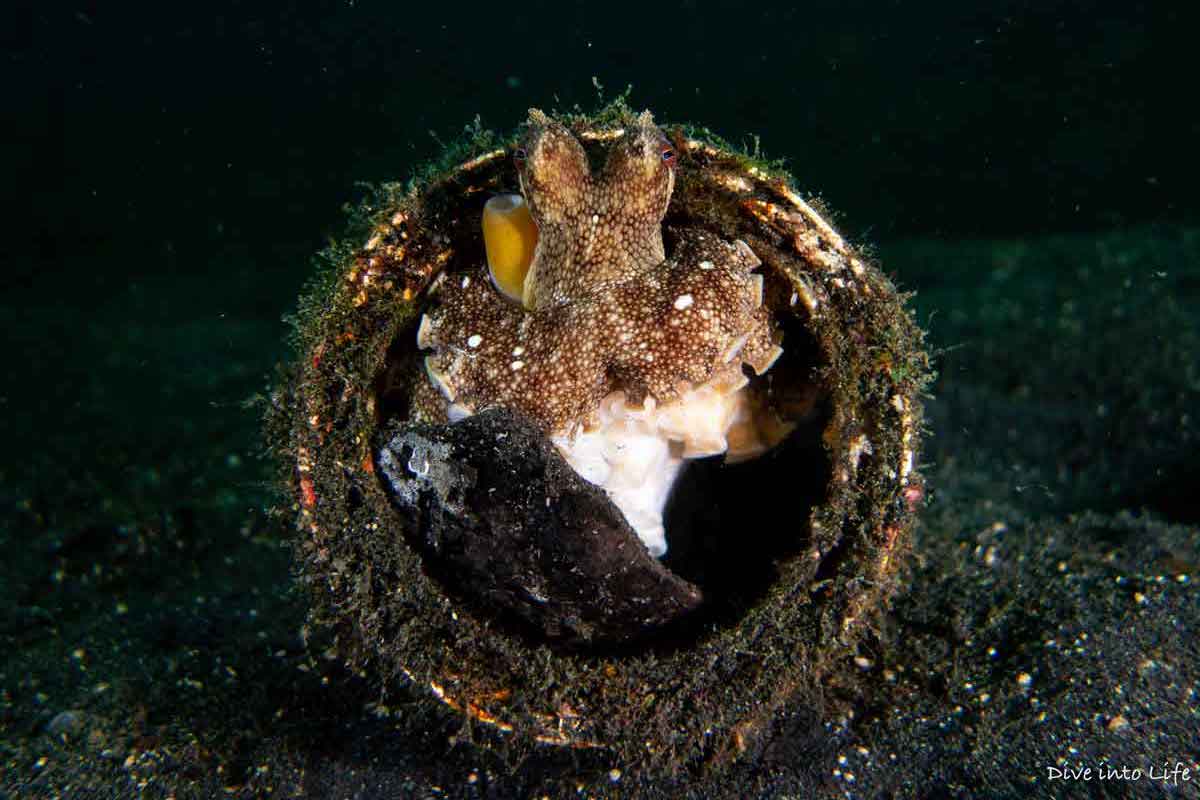
Coconut octopuses are solitary creatures, living alone throughout their life. They are active throughout the day, but focus their hunting on dusk and dawn.
Coconut octopus bury underneath the sand to escape predators but they also lodge themselves inside empty coconut husks – hence their names! When coconut husks are in short supply they will also use bi-valve shells. If no husks or shells are present, they will use natural debris or trash. We have even seen a coconut octopus hiding inside a beer bottle and then use its extended tentacled arm to draw a shell up to itself inside!!
When moving around they carry their host with them underneath the mantle whilst they walk on extended arms as if on stilts. This use of tools and their apparent forward planning is quite unique and makes them one of the most intelligent cephalopods – and it certainly makes them an interesting species to observe.
Research reveals that coconut octopuses possess both short-term and long-term memories, boasting a brain-to-body ratio on par with mammals and birds.
Mating and Reproduction of Coconut Octopus
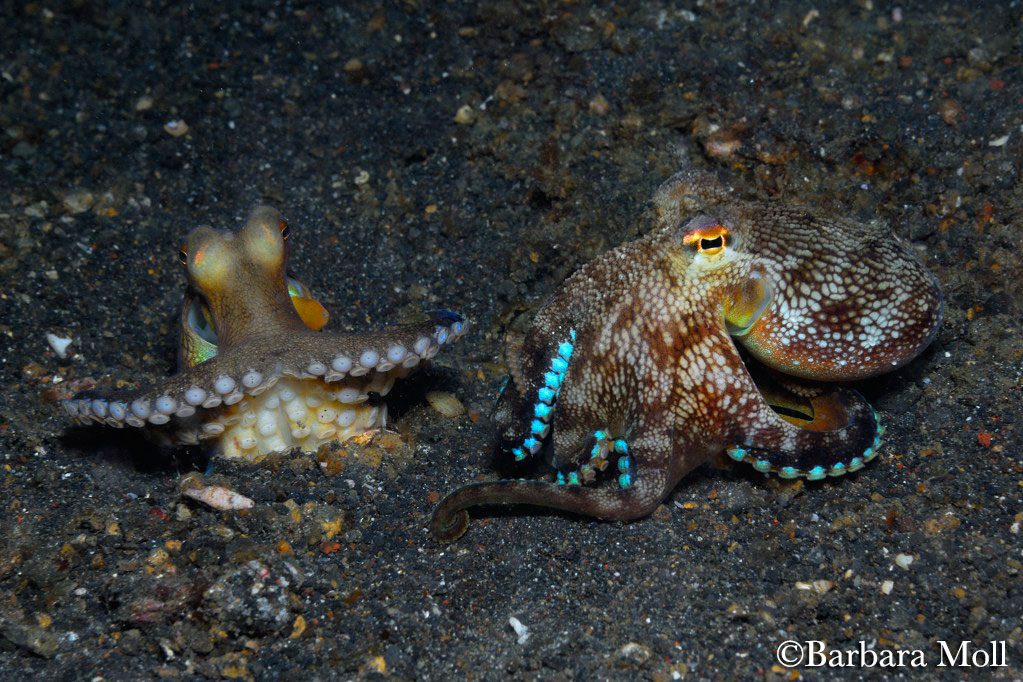
Coconut octopus mating is similar to other octopus species with the male passing the spermatophore with a hectocotylus (a tentacle) into the female’s mantle area. Female coconut octopus are known to eat their counterparts during mating so the male will disguise itself as a female during the process!
There is a gestation period of 11 months, after which the female lays up to 100,000 eggs, each measuring less than 0.24 in (6 mm). The female keeps the eggs in a safe corner or crevice and is extremely protective of them until they hatch. If threatened during this period the female will respond by releasing ink to confuse any predators. Females will often die out of starvation as they do not eat anything during the entire brooding time.
Coconut Octopus Life Cycle and Span
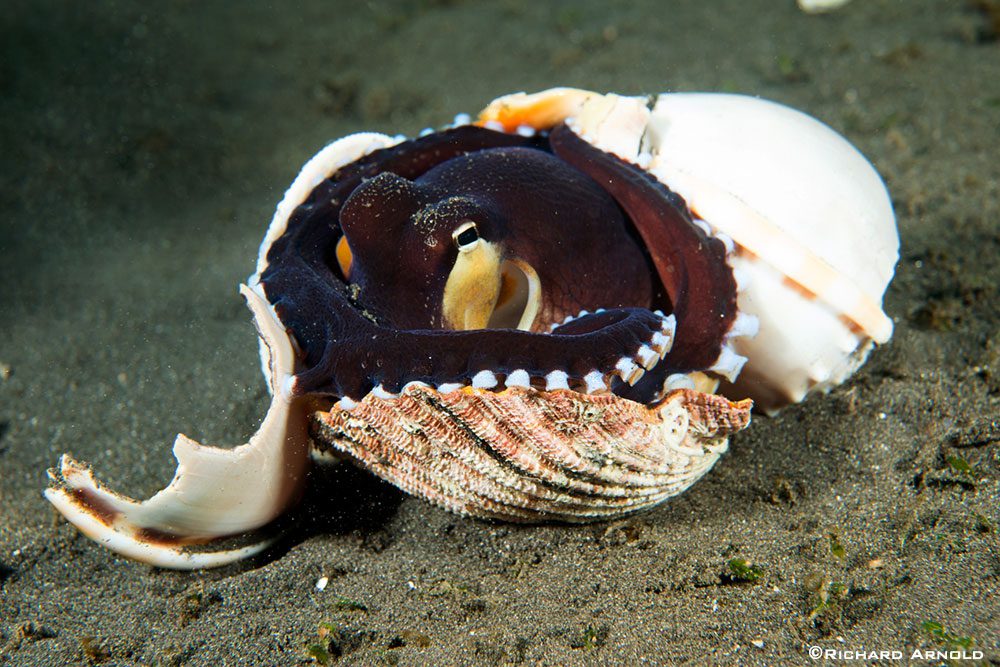
Offspring exist in a larvae form initially. After hatching, they are usually carried out by ocean currents and feed on copepods during this period. It’s possible to see larva stage coconut octopus during our blackwater dives in the Lembeh Strait.
At the age of 1-2 years, coconut octopus reach sexual maturity and they are thought to have a life span of 3 – 5 years in their natural habitat.
Coconut Octopus Habitats and Dive Sites
Coconut octopus are seen in many parts of Indonesia. But here in the Lembeh Strait, they are most at home on our black sand, muck diving sites where they can most easily burrow. Some of our favorite sites for sightings include Air Prang, Hairball 1, 2, and 3, Pantai Parigi and Retak Larry.
Coconut Octopus and Underwater Photography
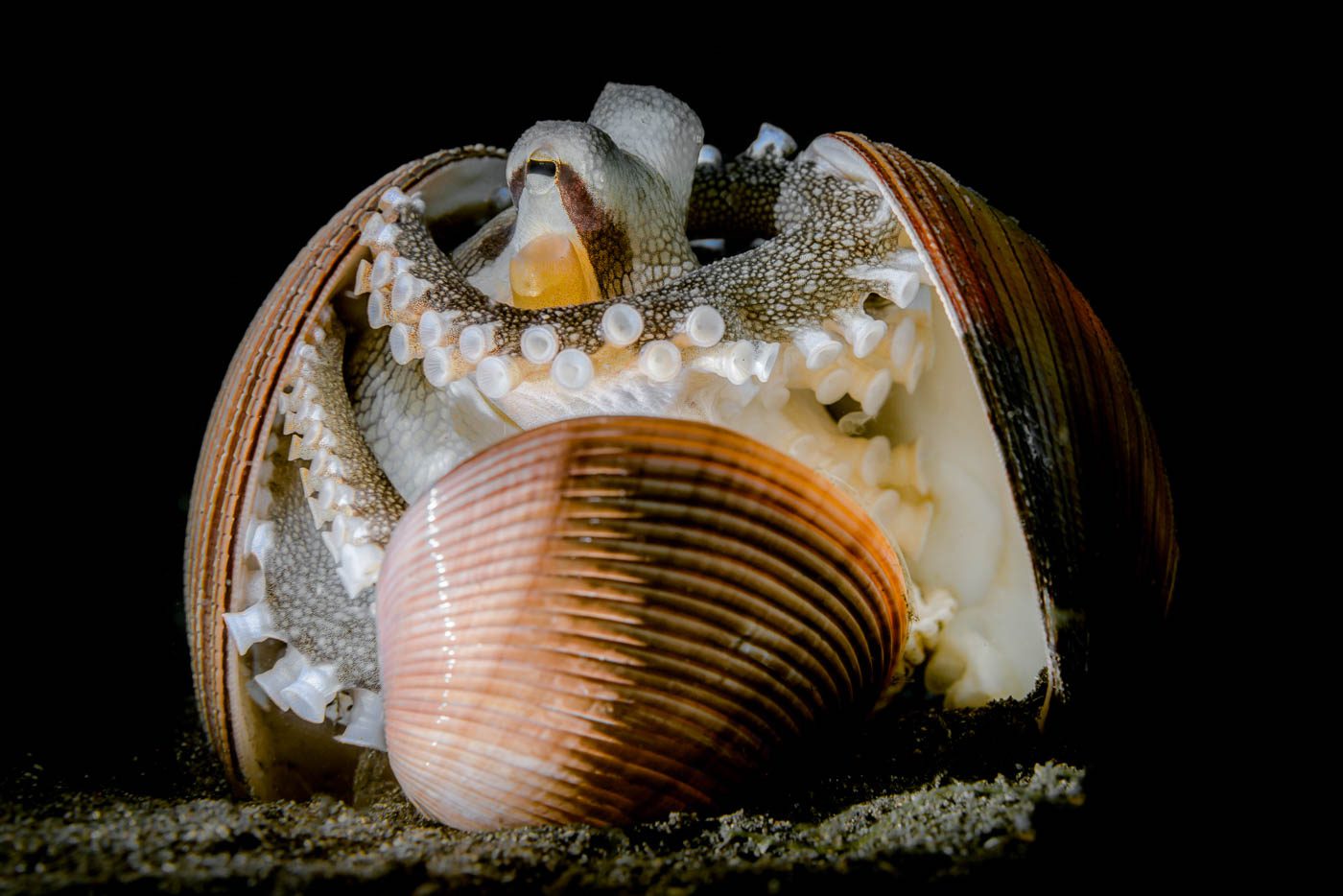
When attempting to photograph coconut octopus, keep in mind that they are a shy species. So ensure that your initial approach is slow and avoid sudden or jerky movements. If you approach carefully and cautiously they will often allow for a close up encounter. Stay down close to the bottom as this is less threatening than towering over them. Some of the best shots of coconut octopus are when they are in shells or other self-constructed ‘homes’.
As this species can measure up to 30cm it can be challenging to have the entire individual in focus but a solid image will have the eye as the focus point.
Equipment and Support at Lembeh Resort
If you would like more advice relating to your specific camera, lenses and lighting gear, call into our Photo Center and speak to our team of Photo Center Assistants – they are always on hand to help and offer guidance. There is also a range of underwater photography equipment and accessories to rent and available for sale.
Elevate Your Underwater Photography with Our 2025 Workshop!
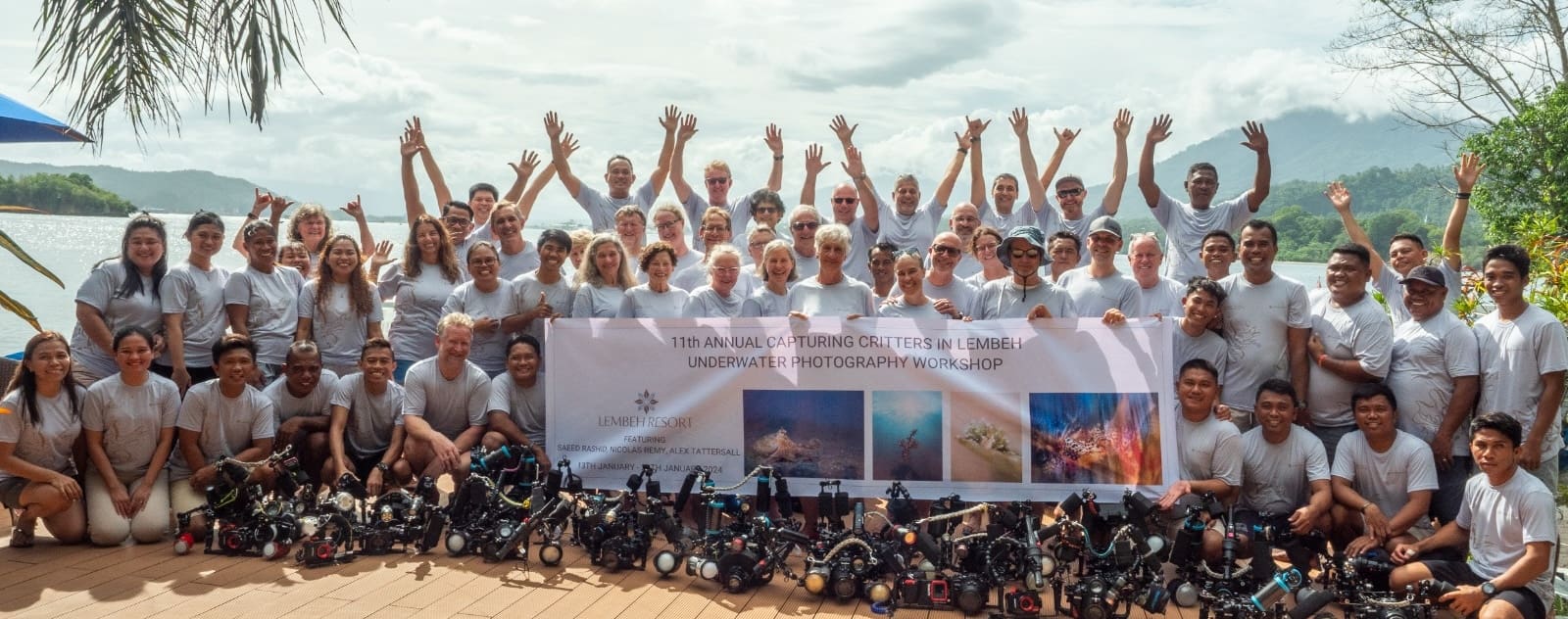 Take your underwater photography to the next level by learning from professional shooters in the captivating Lembeh Strait. Join our annual Capturing Critters in Lembeh Underwater Photography Workshop in 2025!
Take your underwater photography to the next level by learning from professional shooters in the captivating Lembeh Strait. Join our annual Capturing Critters in Lembeh Underwater Photography Workshop in 2025!
In 2025, Lembeh Resort will host three world-class Photo Pros, including Ron Watkins, Renee Capozzola, and Paul Duxfield. The week-long workshop will be filled with incredible diving, Pro presentations, and personalized one-on-one instruction and feedback.
Plan Your Dive Trip and Explore Exciting Lembeh Resort Rates!
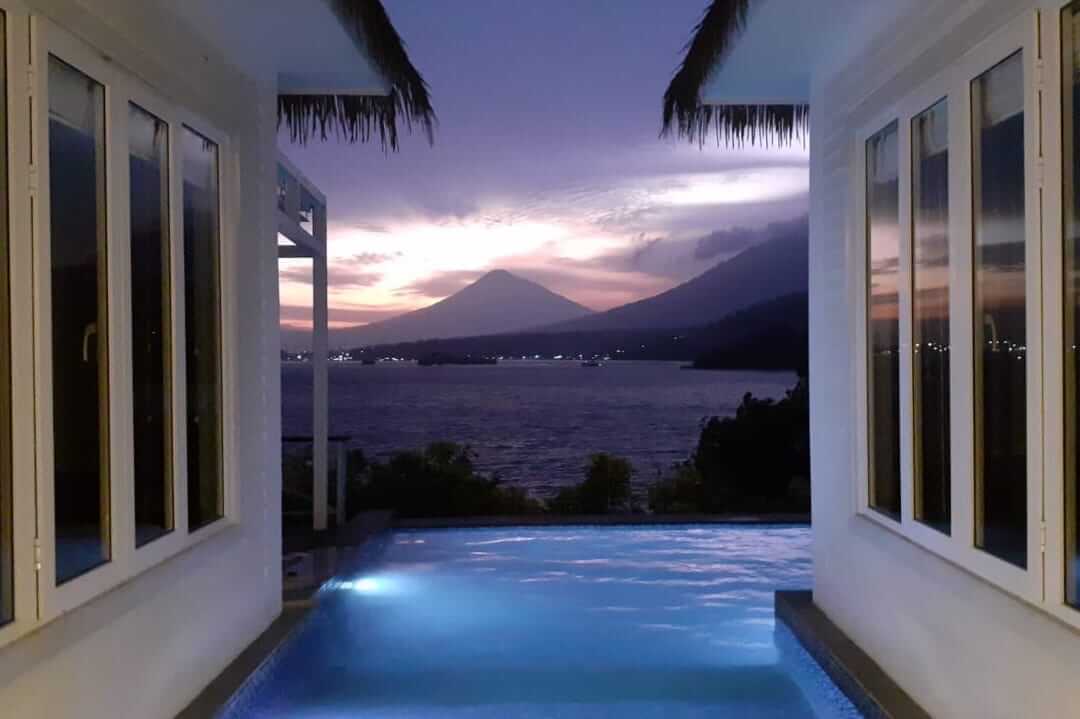 Are you ready for your next dive adventure? Get in touch for more information about staying, diving, or joining our workshop! Send your inquiry to: reservations@LembehResort.com. Unleash your creativity and passion for underwater photography at Lembeh Resort. Don’t miss this incredible opportunity!
Are you ready for your next dive adventure? Get in touch for more information about staying, diving, or joining our workshop! Send your inquiry to: reservations@LembehResort.com. Unleash your creativity and passion for underwater photography at Lembeh Resort. Don’t miss this incredible opportunity!



